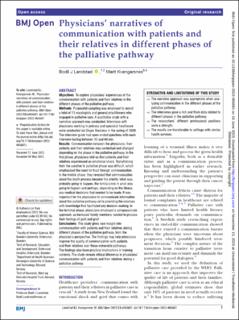| dc.contributor.author | Landstad, Bodil Johanne | |
| dc.contributor.author | Kvangarsnes, Marit | |
| dc.date.accessioned | 2023-11-17T15:49:59Z | |
| dc.date.available | 2023-11-17T15:49:59Z | |
| dc.date.created | 2023-08-24T09:33:30Z | |
| dc.date.issued | 2023 | |
| dc.identifier.citation | BMJ Open. 2023, 13 (6), . | en_US |
| dc.identifier.issn | 2044-6055 | |
| dc.identifier.uri | https://hdl.handle.net/11250/3103333 | |
| dc.description.abstract | Objectives To explore physicians’ experiences of the communication with patients and their relatives in the different phases of the palliative pathway.
Methods Purposeful sampling was employed to recruit a total of 13 oncologists and general practitioners who engaged in palliative care. A qualitative study with a narrative approach was conducted. Interviews with physicians working in primary and specialist healthcare were conducted via Skype Business in the spring of 2020. The interview guide had open-ended questions with each interview lasting between 35 and 60 min.
Results Communication between the physicians, their patients and their relatives was contextual and changed depending on the phase in the palliative pathway. In the first phase, physicians told us that patients and their relatives experienced an emotional shock. Transitioning from the curative to palliative phase was difficult, which emphasised the need for trust through communication. In the middle phase, they revealed that communication about the death process became the priority: what was probably going to happen, the family’s role in what was going to happen and perhaps, depending on the illness, any medical decisions that needed to be made. It was important for the physicians to communicate information about the palliative pathway while providing the relatives with knowledge that facilitated any decision making. In the terminal phase, physicians employed a compassionate approach, as bereaved family members needed to process their feelings of guilt and grief.
Conclusions The study gives new insight into communication with patients and their relatives during different phases of the palliative pathway, from the physician’s perspective. The findings may help physicians improve the quality of communication with patients and their relatives over these vulnerable pathways. The findings also have practical implications in training contexts. The study reveals ethical dilemmas in physicians’ communication with patients and their relatives during a palliative pathway. | en_US |
| dc.language.iso | eng | en_US |
| dc.publisher | BMJ Publishing Group | en_US |
| dc.rights | Navngivelse-Ikkekommersiell 4.0 Internasjonal | * |
| dc.rights.uri | http://creativecommons.org/licenses/by-nc/4.0/deed.no | * |
| dc.title | Physicians' narratives of communication with patients and their relatives in different phases of the palliative pathway | en_US |
| dc.title.alternative | Physicians' narratives of communication with patients and their relatives in different phases of the palliative pathway | en_US |
| dc.type | Peer reviewed | en_US |
| dc.type | Journal article | en_US |
| dc.description.version | publishedVersion | en_US |
| dc.source.pagenumber | 0 | en_US |
| dc.source.volume | 13 | en_US |
| dc.source.journal | BMJ Open | en_US |
| dc.source.issue | 6 | en_US |
| dc.identifier.doi | 10.1136/bmjopen-2022-065681 | |
| dc.identifier.cristin | 2169212 | |
| cristin.ispublished | true | |
| cristin.fulltext | original | |
| cristin.qualitycode | 1 | |

